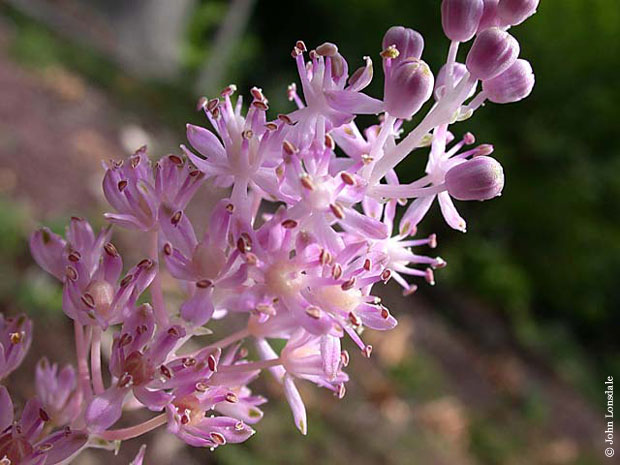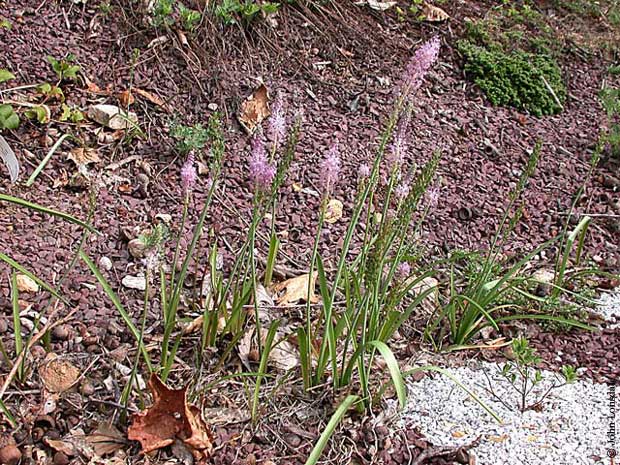Barnardia
Barnardia japonica
The Barnardia are a genus within the family asparagus plants ( Asparagaceae ). From its two species, one is found in the Balearic Islands and in North Africa and the other in East Asia.
Description
Appearance and leaves
Barnardia species grow as perennial herbaceous plants. This form Geophyten onions with a jacket ( " Tunic " ) as outlasting. The leaves are in a basal rosette. The simple leaf blades are linear to almost egg-shaped and parallel-veined.
Inflorescences and flowers
Terminally on ungeblätterten Blütenstandsschäften are racemose inflorescences, meit contain many flowers. The flowers are in axillary small, membranous bracts. The flower stems are broken.
The hermaphrodite flowers are triple. The six identically shaped bracts are free or fused briefly at their base and ascending to spread. There are two circles, each with three stamens present. The inserted at the base or near the center of the bloom stamens are widened a bit thin or towards the base. Dorsifixen the dust bag inwards. The three carpels are fused into a superior ovaries. Each ovary cell contains only one or two or Barnardia numidica eight to ten ovules at Barnardia japonica. The thread-like style ends in a small scar.
Fruit and seeds
The parchment-like, lokulizide capsule fruit is globose to obovate. The black seeds are sometimes edgy.
Systematics and distribution
The genus Barnardia was erected in 1826 by John Lindley in Botanical Register ..., Volume 12, Table 1029. Type species is Barnardia scilloides Lindl., This is a synonym of Barnardia japonica ( Thunb. ) Schult. & Schult.f .. The generic name honors the then Vice- Secretary of the Horticultural Society of London Edward Barnard. A synonym for Barnardia Lindl. is Simira Raf ..
The genus belongs to the subtribe Barnardia Hyacinthinae from the tribe Hyacintheae in the subfamily Scilloideae within the family Asparagaceae. The two species were formerly classified in the genus Scilla and in the families Hyacinthaceae or Liliaceae.
According to Ali et al. 2012 are not closely related to the two species, and there are two monotypic genera. For Barnardia numidica a new genus would be set up.
There are only two types of Barnardia. Of the two species, one comes to the Balearic Islands and in North Africa and the other in East Asia before:
- Barnardia japonica ( Thunb. ) Schult. & Schult.f. It occurs in China, Taiwan, Japan, Korea and eastern Russia ( Primorye ).
- Barnardia numidica ( Poir. ) Speta: It comes in the Balearic Islands, in Algeria, Tunisia and Libya.
Swell
- Chen Xinqi (陈心启) & Minoru N. Tamura: Barnardia, pp. 203 - text the same online as printed work, In: Wu Zheng -yi, Peter H. Raven (eds.): Flora of China, Volume 24 - Flagellariaceae through Marantaceae, Science Press and Missouri Botanical Garden Press, Beijing and St. Louis, 2000. ISBN 0-915279-83-5 (Section Description, distribution and systematics)
- Syed Ali Shujait, Yan Yu, Martin Pfosser & Wolfgang Wetschnig: Inferences of biogeographical histories within subfamily Hyacinthoideae using S- DIVA and Bayesian binary MCMC analysis Implemented in RASP ( Reconstruct Ancestral State in phylogenies ). In: Annals of Botany. Volume 109, No. 1, 2012, pp. 95-107. doi: 10.1093/aob/mcr274 ( here: p 101).
- Franz Speta: Systematic analysis of the genus Scilla L. sl ( Hyacinthaceae ). In: Phyton ( Horn ). Volume 38, No. 1, 1998, pp. 1-141, 29.7 MB PDF file.








